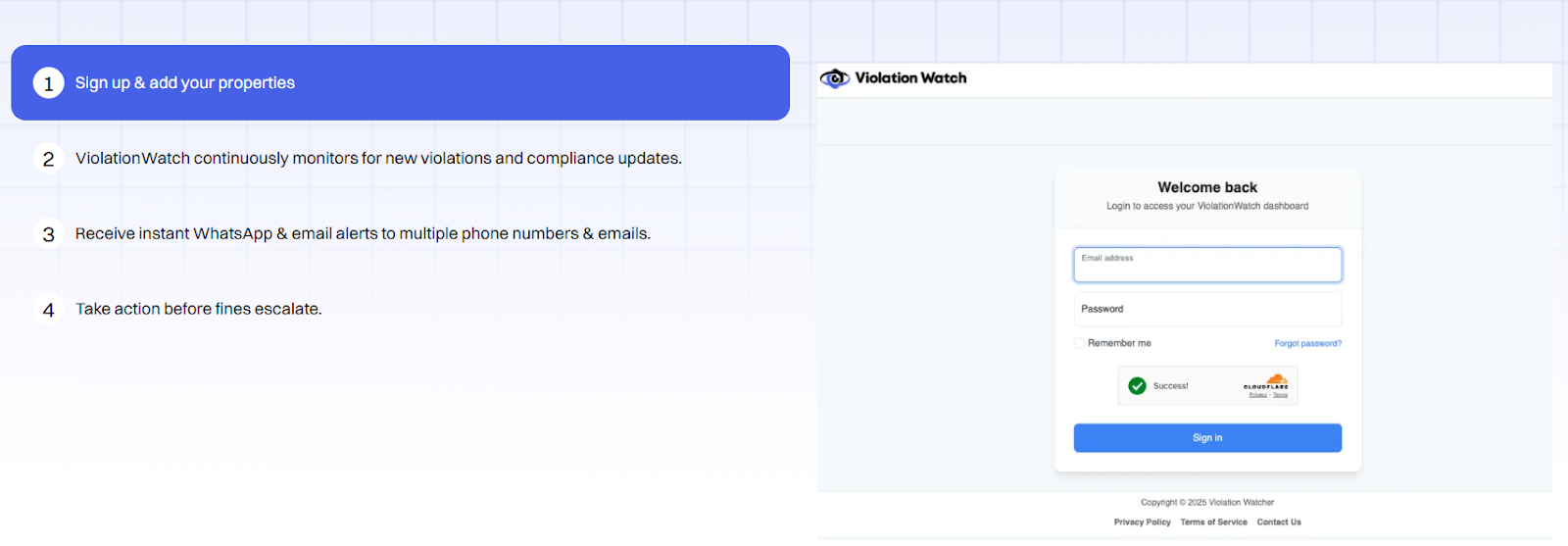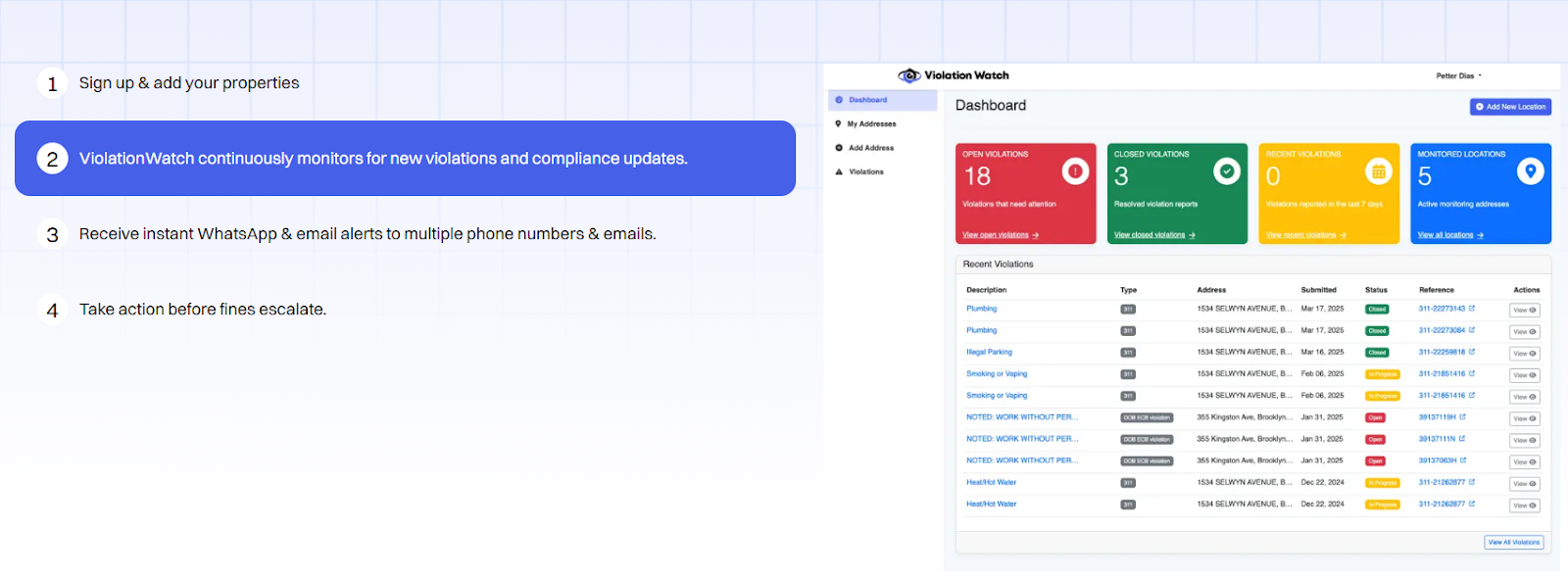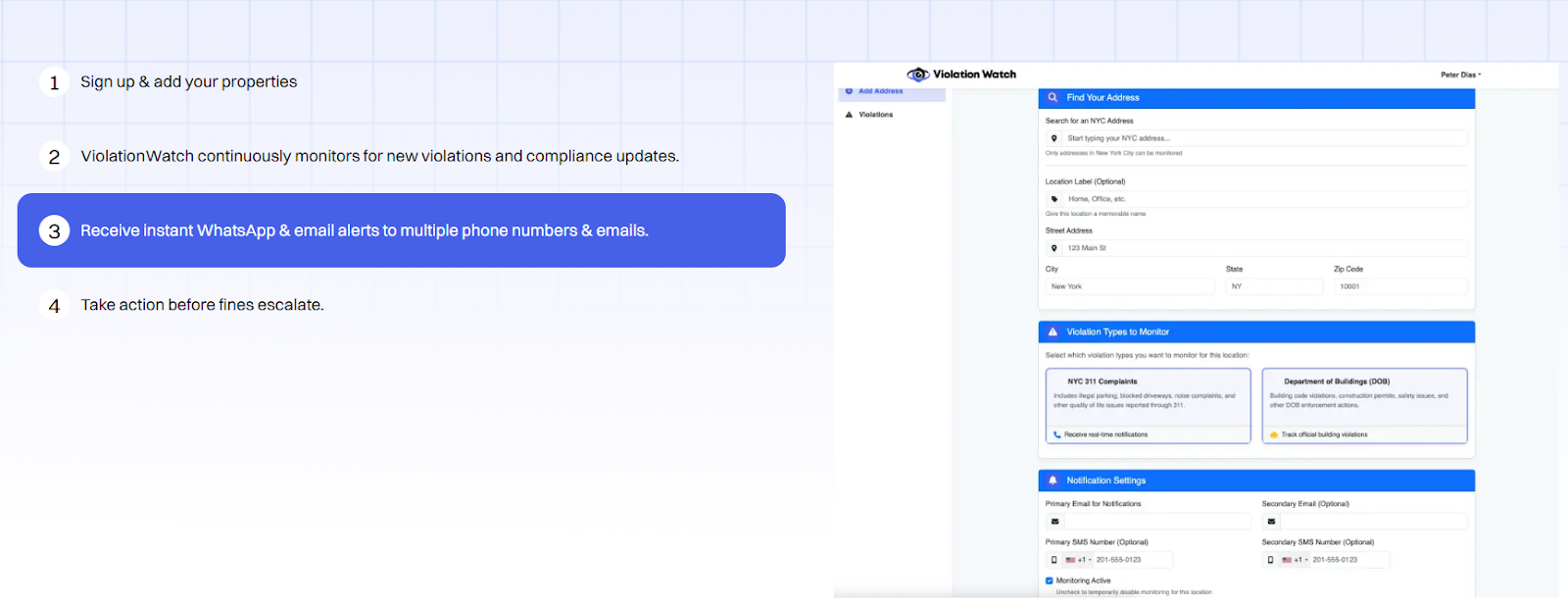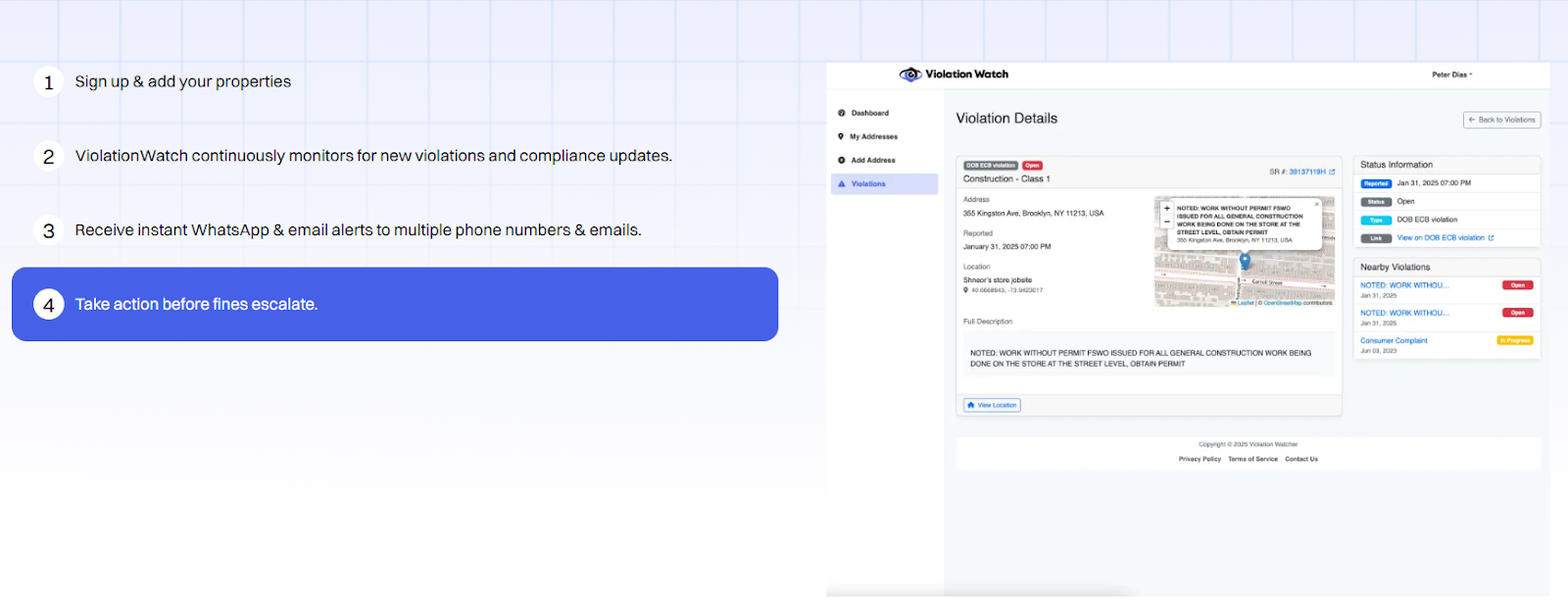Some repairs can wait. Others can’t. And in NYC? The clock’s already ticking the moment a tenant files a complaint. Let this slip, and it snowballs—complaints turn into violations, violations into fines, and fines into liens. That’s how fast things move here. And no, you don’t get extra time for good intentions. So the question isn’t if you should act. It’s how fast you have to.
NYC housing law doesn’t play favorites. Once a tenant notifies 311 or the Department of Housing Preservation and Development (HPD), you’re locked into a legally defined timeline. Doesn’t matter if it’s a loose banister or no heat in the dead of winter—there’s a fix-by deadline stamped on your responsibility.
In this article, you’ll get a clear, no-nonsense breakdown of:
- What the NYC housing law says about mandatory repair timelines
- How long you have to fix Class A, B, and C violations
- What defines “emergency,” “hazard,” and “non-hazardous” repairs
- What happens if you blow past the deadline
- The real cost of dragging your feet—fines, liens, and enforcement
- Why relying on manual tracking puts you at risk
- How to stay ahead of violation deadlines using ViolationWatch
Messy spreadsheets and outdated tracking tools won’t keep you compliant—not in a city that hands out thousands of violations every week. If you manage buildings in NYC, you need more than guesswork. You need speed, clarity, and a system that doesn’t let anything slip. We’ll show you how to handle every repair by the book—and how ViolationWatch makes sure you never miss a deadline again.
NYC Emergency Repair Timelines Aren’t Flexible—They’re Enforced
There’s no wiggle room here. NYC housing law spells out exactly how long a landlord has to fix something based on the type of violation. If the deadline’s missed, enforcement follows—fast and hard.
The Housing Maintenance Code, overseen by the Department of Housing Preservation and Development (HPD), splits repairs into three classes: A, B, and C. Each class comes with its own urgency and deadline. No interpretation. No extensions for effort.
Here’s how it works.
Class A Violations – What You Still Need to Fix Before It Costs You
Class A violations are labeled non-hazardous, but that doesn’t mean they’re harmless or low priority. These are compliance issues tied to quality-of-life standards and long-term habitability. Landlords often underestimate them because they don’t pose immediate health or safety threats. That’s a mistake.
What Class A Covers
This class includes conditions that impact general upkeep, maintenance standards, and tenant livability. Common examples include:
- Peeling or flaking paint not associated with lead
- Missing or damaged window screens
- Cracked tiles or broken baseboards
- Faulty light fixtures in common areas
- Inadequate janitorial service in non-HRA multiple dwellings
Legal Deadline and Compliance Timeline
You have 90 days to correct Class A violations from the date they’re issued. That’s a firm deadline—based on the notice of violation, not when you discover it.
But here’s what many overlook: you must file a Certificate of Correction (C of C) with HPD, signed and notarized, before the deadline closes. Simply making the repair without submitting the paperwork won’t stop enforcement.
What Happens If You Ignore It
HPD will not forget about a Class A violation. The longer it sits unresolved in the system, the more it undermines your record. This can:
- Trigger inspections during re-registration cycles
- Affect loan underwriting and insurance premiums
- Block your ability to self-certify future repairs
- Lead to litigation or HPD repairs billed directly to you
Class B Violations
Class B violations fall under hazardous conditions. These are issues that create potential safety or health concerns and require a quicker turnaround than Class A.
They often stem from recurring complaints and escalate fast when tenants get frustrated.
Typical Class B Violations
- Evidence of mold growth under 10 square feet
- Rodent or insect infestation
- Blocked fire escapes
- Water leaks not damaging structural elements
- Doors that fail to self-close
- Minor plumbing code violations
The kicker? What starts as Class B can become Class C if the condition worsens, especially mold, vermin, or compromised egress.
Legal Deadline
You have 30 days from the notice issue date to fix a Class B violation and submit the C of C to HPD. That’s not 30 business days. It includes weekends and holidays. Don’t let the timeline fool you into slowing down—HPD re-inspects regularly. If you wait too long, the next visit could result in reclassification.
Enforcement Risk
Delayed response to Class B violations often leads to:
- Civil penalties are calculated per day of non-compliance
- Full-building inspections (which open the door to more violations)
- Disqualification from HPD’s “Professional Certification” program
- Issuance of orders to correct and, in some cases, litigation
Landlords managing multiple buildings should treat Class B violations as operational emergencies, especially in buildings with prior complaints or poor scorecards.
Class C Violations
This is where the law gets aggressive. Class C violations are categorized as immediately hazardous conditions that pose direct threats to tenant health, safety, or life.
HPD treats these as top-priority enforcement actions. And they don’t wait for cooperation. If you don’t move fast, the City will step in—and you’ll foot the bill.
What Falls Under Class C
- No heat or hot water during heating season (Oct 1 – May 31)
- Lead-based paint hazards in units with children under 6
- Carbon monoxide or gas leaks
- Exposed wiring, sparking outlets, or circuit overloads
- Elevator outages in required buildings
- Unsafe structural elements, such as crumbling facades or staircases
- Illegal occupancies or blocked egress routes
Legal Timeframe
For most Class C violations, you’re required to correct the condition within 24 hours. The countdown begins immediately after HPD serves the notice—either in person or via certified mail.
In some cases, HPD will grant slightly extended deadlines, such as 5 days for specific lead-paint abatement or 21 days for pest-related Class C issues. But these are the exception, not the rule—and they require proof of good faith and ongoing correction efforts.
What Happens When You Miss the Window?
HPD doesn’t wait long to act. If you fail to correct and submit the C of C on time, here’s what happens:
- Emergency Repair Program (ERP): HPD can dispatch City contractors to correct the hazard, then bill you, with interest and administrative fees attached.
- Civil penalties can accrue daily. For heat/hot water violations, that could mean $250–$500 per day, per unit.
- DOF tax liens may be issued for unpaid repair bills, eventually resulting in foreclosure if ignored.
- Litigation: Chronic Class C non-compliance can escalate into Housing Court proceedings, full-building orders, or even criminal complaints for egregious neglect.
Letting Class C issues linger is the fastest way to lose control of your building’s compliance status—and your repair budget.
Drag Your Feet on Repairs and You’ll Pay for It
HPD doesn’t issue warnings. They issue penalties. If a violation deadline slips by—even a minor one—the consequences multiply quickly. It’s not just about compliance. It’s about protecting your property’s legal and financial standing.
Daily Fines Add Up Fast
Every day you miss a deadline, the City adds penalties. These aren’t symbolic. They’re calculated, cumulative, and enforced through administrative codes.
- Class A violations may trigger civil penalties starting at a few hundred dollars.
- Class B violations often carry per-day fines if conditions remain uncorrected beyond the 30-day mark.
- Class C violations have the harshest penalties—daily charges increase based on unit count, severity, and re-inspection outcomes.
Once the fine is assessed, it doesn’t stop until HPD accepts a certified correction. You can’t stop the clock without proof in hand.
HPD Repairs the Violation—Then Bills You
For immediately hazardous issues, HPD doesn’t wait around. If you don’t fix the condition within the legal timeframe, the agency can send out its own contractors under the Emergency Repair Program (ERP).
The full cost—including labor, materials, and administrative fees—gets billed directly to the owner. There’s no negotiation. You won’t get a discount for delay or dispute.
Non-Payment Triggers Liens
If the City repairs your violation and you don’t pay the invoice within 60 days, it becomes a Department of Finance (DOF) lien on your property.
These liens are serious. They carry interest and can restrict:
- Refinancing or selling the property
- Obtaining permits
- Access to insurance and financing
If ignored, these liens can eventually trigger foreclosure proceedings through NYC’s annual lien sale process.
Repeat Offenses Lead to Legal Action
Chronic non-compliance triggers more than fines. It brings court involvement. HPD, in coordination with the City Law Department, may pursue:
- Civil litigation in Housing Court
- Building-wide inspection sweeps
- Injunctions or restraining orders barring occupancy
- Appointment of 7A administrators, stripping management control from the owner
You don’t need dozens of violations to get flagged. Repeated issues with response time—especially on Class C repairs—send a clear message to the City: the building isn’t being managed responsibly.
And once you’re in Housing Court, every move you make is under scrutiny.
Why Manual Violation Tracking Fails for Building Owners

Post-it notes, spreadsheets, calendar reminders—they all fall short when the pressure’s on. Managing violations manually creates blind spots that no busy property team can afford. Deadlines get missed. Hearing dates sneak up. Paperwork slips through the cracks. And the City doesn’t care how it happened—only that it did.
Even when the law requires the landlord to make repairs, especially for non-hazardous conditions, failing to act in a timely manner can lead to serious enforcement. Yet many landlords still rely on outdated tracking methods, putting their portfolios and reputations at risk.
Let’s break down where manual tracking collapses under real-world conditions.
You’re Relying on Human Memory
Even the sharpest operators miss things when the workload piles up.
- One missed email can cost thousands
- Verbal updates from staff don’t leave a trail
- Memory-based systems don’t scale beyond a few buildings
When non-emergency repairs fall through the cracks, even small issues like minor leaks or tenant-caused damage can spiral into costly violations.
Data Is Scattered Across Systems
Property management software, inboxes, PDFs, post-inspection notes—it’s a mess.
- No single place shows all open violations across agencies
- Sorting DOB vs HPD vs ECB timelines requires hours
- Status updates get delayed when information lives in multiple silos
The burden usually lands on the managing agent to pull everything together, while juggling other tasks tied to the rental unit and broader compliance.
You Can’t Automate Time-Sensitive Triggers
Manual tracking forces you to react late—after the clock’s already ticking.
- No alerts for upcoming hearing dates
- No auto-reminders tied to compliance deadlines
- No change notifications when violation status updates online
This lag leaves necessary repairs unaddressed. And when tenants don’t see progress, they may immediately contact the city’s department or push for rent abatements under local enforcement guidelines.
Recordkeeping Breakdowns Risk Certification Rejections
HPD and DOB require certified submissions—on time, in full.
- Missing correction affidavits invalidate repair efforts
- Incomplete documentation stalls dismissal requests
- Lost paperwork delays fine reductions and settlement offers
When tenants feel ignored, most leases allow them to withhold rent or file for housing stability protections. These gaps erode trust and expose owners to regulatory and legal action.
Portfolio Growth Makes Errors Inevitable
What works for 2 buildings won’t work for 20.
- More addresses mean more deadlines to track
- Cross-referencing agency portals becomes a full-time job
- Staff turnover or vacation can create multi-week blind spots
Manual logs don’t scale. And delays—even for what seems like normal wear—can prompt tenant complaints, demands for a reasonable amount of repairs, or even lead them to consult legal counsel when delays stretch beyond a reasonable time.
When systems break, enforcement doesn’t pause. If you’re tracking compliance with sticky notes and shared folders, it’s only a matter of time before something slips. Staying proactive means moving beyond patchwork methods before missed deadlines turn into penalties and rent losses.
Stay Ahead of Violation Deadlines Without Scrambling
Staying compliant in NYC isn’t about catching up—it’s about staying ahead. The moment a violation gets filed, the countdown starts. And the penalties pile up fast if your system isn’t built for speed, accuracy, and accountability.
New York law doesn’t wait for manual processes. It requires timely action, full documentation, and strict compliance across agencies. Every missed deadline puts your rental property at risk—not just for fines, but for legal exposure under local laws governing repair timelines and tenant protections.
Manual methods can’t keep up. You need real-time visibility across all city agencies. You need clear action paths. You need alerts before deadlines close, not after. That’s exactly where ViolationWatch changes the equation.
Why ViolationWatch Works When Others Don’t
We built ViolationWatch to solve the core problem: delay. The platform gives you full visibility across your entire portfolio, with zero blind spots. No more chasing inspectors, missing DOB updates, or relying on guesswork.
Here’s how it closes the gap:
- All violations tracked from DOB, HPD, ECB, FDNY, and more—on one screen
- Instant alerts sent to your team via WhatsApp and email
- Status changes update automatically, no logins required
- You never miss a compliance window, hearing, or fine escalation
If a landlord fails to correct a violation within the legally defined timeframe, that delay can trigger a financial penalty, a rent reduction, or a legal complaint with local housing authorities. And if the violation impacts essential services—like heat, water, or gas—it becomes a breach of the lease agreement and the landlord’s responsibility under New York State law.
Whether you’re managing two buildings or two hundred, the dashboard scales with you. And you stay ahead—by default.
How ViolationWatch Keeps You On Schedule
Below is the exact workflow that keeps your violations from slipping through the cracks:
1. Sign up and add your properties

- Search by NYC address and tag each property with a label
- Choose which agencies to monitor per location
- Add primary and backup contacts for alerts
If you’re using a management company, they can be looped in with custom notifications per site, ensuring no violations go unseen or unresolved.
2. Automatic violation monitoring starts immediately

- The system checks for new DOB, HPD, ECB, and 311 records
- You’ll see violations flagged by status: open, in progress, or closed
- Everything updates daily, so your dashboard reflects reality
In many cases, prior notice requirements under New York law are met simply by documenting alerts and timelines through the platform’s interface.
3. Get real-time alerts to the right people

- Receive instant alerts for new violations and approaching deadlines
- Choose WhatsApp, email, or both
- Send to multiple numbers, so your super, manager, and legal team stay looped in
When you’re dealing with urgent repairs, time matters. These alerts can help prevent escalation, tenant complaints, or efforts to pursue legal action due to perceived neglect.
4. Act before enforcement starts

- Use live status tracking to prioritize what needs action
- Pull detailed records, reference numbers, and submission logs
- Resolve issues before HPD, DOB, or ECB push it to the next phase
By taking prompt action, landlords can avoid situations where a tenant demands their tenant’s security deposit be returned early or brings in legal representation under the Tenant Protection Act.
Whether you’re fighting off fines, protecting your rent roll, or managing investor scrutiny, timing is everything. ViolationWatch gives you the lead time and data edge you need to act fast, stay clean, and keep your properties off enforcement lists—while staying fully compliant with every clause, code, and timeline written into city and state housing laws.
NYC Repair Timelines Made Simple With ViolationWatch
The rules aren’t vague. The deadlines aren’t flexible. And the City doesn’t wait around. If you’re managing buildings in New York City, staying on top of repair windows isn’t optional—it’s part of protecting your bottom line. This article gave you the technical clarity and legal context you need to take control of those timelines before they take control of your budget.
Whether you’re navigating rent laws, facing inspection cycles under community renewal programs, or trying to provide reasonable notice for non-emergency work, the pressure to get it right is constant. Delay doesn’t just mean risk—it means liability.
Let’s break down what you now have in your corner—and what it leads to when put into practice:
- Clear legal breakdown of Class A, B, and C violations→ Know which issues trigger which deadlines—and what happens if you miss them
- A detailed view of the enforcement pipeline→ Spot fines, liens, ERP charges, and Housing Court before they catch you off guard
- Proof that manual tracking creates compliance gaps→ Cut down the risk of human error, paperwork loss, and deadline misfires
- A simple, tech-driven system to monitor every violation→ Centralize alerts, status updates, and property records in one place
When all of these align, the result is simple: fewer fines, faster response times, and full visibility across your entire portfolio.ViolationWatch was built to handle this process, so you don’t have to chase paper trails or second-guess deadlines. With smart alerts, centralized dashboards, and automatic updates across all major agencies, it’s the difference between reacting to violations and controlling the timeline. Because in this city, speed isn’t a luxury. It’s what keeps your buildings compliant—and your margins safe.

